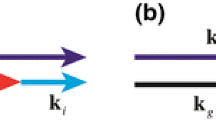Abstract.
We show that in the limit of negligible pump depletion, the spatial distribution of the quantum fluctuations in spontaneous parametric down-conversion can be computed for any shape of the pump beam by using the Green’s function method to linearize the quantum fluctuations, even for very low levels of the intensities measured on the pixels. The results are in complete agreement with stochastic simulations of the Wigner distribution. Both methods show specific quantum effects in realistic situations close to the experiments now in progress, like sub-shot noise correlation between opposite pixels in the far field.
Similar content being viewed by others
References
A.F. Abouraddy, B.E.A. Saleh, A.V. Sergienko, M.C. Teich, J. Opt. Soc. Am. B 19, 1174 (2002)
E. Brambilla, A. Gatti, L.A. Lugiato, Eur. Phys. J. D 15, 127 (2001)
A. Heidmann, R.J. Horowicz, S. Reynaud, E. Giacobino, C. Fabre, G. Camy, Phys. Rev. Lett. 59, 2555 (1987); O. Aytür, P. Kumar, Phys. Rev. Lett. 65, 1551 (1990)
A. Gatti, E. Brambilla, L.A. Lugiato, M.I. Kolobov, Phys. Rev. Lett. 83, 1763 (1999)
B.M. Jost, A.V. Sergienko, A.F. Abouraddy, B.E.A. Saleh, M.C. Teich, Opt. Expr. 3, 81 (1998)
F. Devaux, E. Lantz, Eur. Phys. J. D 8, 117 (2000)
D.F. Walls, G.J. Milburn, Quantum Optics (Springer Verlag, Berlin, 1994)
S. Reynaud, A. Heidman, E. Giacobino, C. Fabre, Progr. Opt. 30, 3 (1992)
N. Treps, C. Fabre, Phys. Rev. A 62, 033816 (2000)
A. Gatti, H. Wiedemann, L.A. Lugiato, I. Marzoli, G.L. Oppo, S.M. Barnett, Phys. Rev. A 56, 877 (1997)
E. Lantz, F. Devaux, Eur. Phys. J. D 17, 93 (2001)
E. Brambilla, A. Gatti, M. Bache, L.A. Lugiato, Phys. Rev. A 69, 023802 (2004)
A. Mosset, F. Devaux, G. Fanjoux, E. Lantz, Eur. Phys. J. D 28, 447 (2004)
O. Jedrikiewicz, Y. Jiang, P. Di Trapani, E. Brambilla, A. Gatti, L.A. Lugiato, EH5-4-THU, CLEO/EQEC 2003, Munich
A. Yariv, Quantum Electronics, 3rd edn. (John Wiley & Sons, 1988), Chaps. 16 and 17
M.I. Kolobov, Rev. Mod. Phys. 71, 1539 (1999)
If losses were present (for example absorption), coupling with a vacuum operator would have to be introduced in order to preserve the unitary conditions. See: M.I. Kolobov, L.A. Lugiato, Phys. Rev. A 52, 4930 (1995). In this reference, this operator resulted from a finite pupil after the crystal and had no consequence on any normally-ordered correlation function. However, losses inside the crystal would imply a different situation, with actual parametric fluorescence generated from this introduced vacuum. This situation is outside the scope of the paper
C. Gardiner, Quantum noise (Springer, Berlin, 1991)
F. Devaux, E. Lantz, Opt. Commun. 114, 295 (1995)
Note that this property vanishes for higher gains: \(\tilde {C}_{\vec {r},\vec {r}} \) and \(\tilde {C}_{\vec {r},-\vec {r}} \) become almost equal for intensities of several tens of photons per pixel and \(\tilde {C}_{\vec {r},\vec {r}} \) becomes very slightly greater than \(\tilde {C}_{\vec {r},-\vec {r}} \) for intensities greater than 300 photons per pixel. This evolution confirms that quantum effects are more visible when thermal-like fluctuations are not too intense. It is not clear if the complete disappearance of quantum effects for high gains is physical or due to numerical accuracy problems. On the experimental side however, it is quite clear that the sub-shot noise level on the differences cannot be attained when the shot-noise fluctuations are very small compared to the thermal fluctuations
Author information
Authors and Affiliations
Corresponding author
Additional information
Received: 15 January 2004, Published online: 23 March 2004
PACS:
42.65.Yj Optical parametric oscillators and amplifiers - 42.50.-p Quantum optics - 42.65.-k Nonlinear optics
Rights and permissions
About this article
Cite this article
Lantz, E., Treps, N., Fabre, C. et al. Spatial distribution of quantum fluctuations in spontaneous down-conversion in realistic situations. Eur. Phys. J. D 29, 437–444 (2004). https://doi.org/10.1140/epjd/e2004-00040-4
Issue Date:
DOI: https://doi.org/10.1140/epjd/e2004-00040-4




